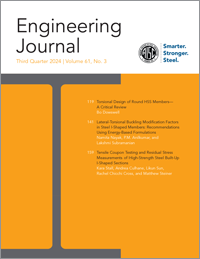Lateral-Torsional Buckling Modification Factors in Steel I-Shaped Members: Recommendations Using Energy-Based Formulations
DOI:
https://doi.org/10.62913/engj.v61i3.1328Keywords:
lateral torsional buckling, LTB modification factor, Rayleigh-Ritz method, warping restraints, continuous beamsAbstract
Lateral torsional buckling (LTB) is of concern in long-span flexural members, particularly in the negative flexure regions of continuous-span, steel I-shaped members and during construction. While the elastic critical LTB capacity of a simply supported I-shaped member subjected to uniform moment has a closed-form solution, most LTB modification factors for beams subjected to moment gradients in the literature are empirical and work well only for specific loading and boundary conditions. This paper investigates the suitability of the different LTB modification factors in literature and design specifications for various loading and boundary conditions, accomplished via comparisons with analytical solutions using the Rayleigh-Ritz method and numerical solutions from finite element analyses. The analytical LTB modification factors are derived for doubly symmetric I-shaped members with different combinations of ideal flexural and torsional boundary conditions (simply supported and fixed) and subjected to different loading scenarios. The validity of the LTB modification factors determined using the Rayleigh-Ritz method and other formulae in the literature are also assessed for realistic intermediate restraint conditions, which are neither fully pinned nor fixed, by examining laterally continuous beams. Demonstrating that current design specifications for elastic critical LTB modifications are overly conservative

